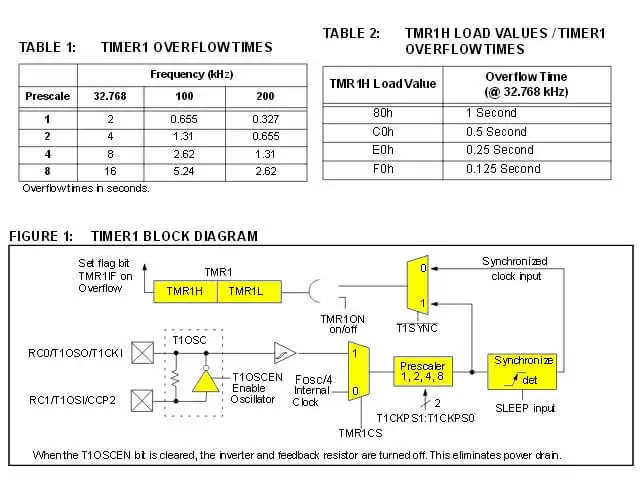
External Crystal Uses PIC16F628 TMR1 Generates Interrupt
by Lewis Loflin
A crystal oscillator circuit is built in between pins T1OSI (input) and T1OSO (amplifier output). It is enabled by setting control bit T1OSCEN (T1CON bit 3). The oscillator is a low power oscillator rated up to 200 kHz. It will continue to run during SLEEP. It is primarily intended for a 32 kHz crystal.
As a 16-bit timer with it's own clock source a real time clock base is easy to implement. Note the values in Tables 1 and 2 above. Compare to using TMR0 at PIC16F628 Timer 0 Interrupt Programming Tutorial.
The full ASM can be downloaded: PIC16F628A_TMR1.asm
;***************************** ORG 0x000 ; processor reset vector goto setup ; go to beginning of program ORG 0x004 ; interrupt vector location begin here movwf w_temp ; save off current W register contents movf STATUS,w ; move status register into W register movwf status_temp ; save off contents of STATUS register ; ISR code can go here or be located ; as a call subroutine elsewhere movlw 0x80 ; reload TMR1 movwf TMR1H bcf PIR1, TMR1IF ; clr TMR1 interrupt flag call toggle ; flip state on RA0 ; end ISR movf status_temp,w ; retrieve copy of STATUS register movwf STATUS ; restore pre-isr STATUS register contents swapf w_temp,f swapf w_temp,w ; restore pre-isr W register contents retfie ; return from interrupt ;*******************************************
Above is the interrupt service routine or ISR. Again we save the W and STATUS registers and restore before RETFIE ending the ISR.
bsf PIE1, TMR1IE ; enable TMR1 interrupt banksel INTCON clrf PORTA clrf PORTB bsf INTCON, GIE ; enable global interrupt bsf INTCON, PEIE ; enable all unmasked interrupts bcf PIR1, TMR1IF ; clr TMR1 interrupt flag clrf T1CON bsf T1CON, TMR1ON ; Timer1 On bit bsf T1CON, TMR1CS ; external oscillator crystal bsf T1CON, 2 ; T1SYNC set to asynchronous bsf T1CON, T1OSCEN ; Timer1 Oscillator Enable Control bit ; two lines below same as 5 lines above ; movlw b'00001111' ; movwf T1CON clrf TMR1L ; set to 0 movlw 0x80 ; value for 1 sec. delay movwf TMR1H ; must be reloaded after every interrupt
Above is the setup code to use the 32 kHz. crystal programmed to generate an interrupt every 1 second. This is regardless of the frequency of the main system clock in my case a 16 mHz. crystal.
See How I got into Electronics
- You Tube Videos for this Series
- Home Built PIC Development Board
- PIC16F628 PIC Using Rotary Encoder to Operate Stepper Motor
- Using a Serial ADC with PIC16F628
- Calculating Pulse-Width Modulation with a PIC
- PIC16F84A-628A Hardware Time Delays
- PIC16F84A-628A Timer Interrupt Delays
- PIC16F84A-628A Pullups and Interrupts
- PIC16F84A-628A Hardware Interrupts Tutorial
- Projects using PIC16F628:
- Home Built PIC16F628 Prototyping Board
- Exploring the Microchip PIC in Assembly
- Using a Microchip PIC with TLC548 Serial ADC
- Controlling PIC Pulse Width Modulation with a Serial ADC
- Using TMR0 on a PIC with Interrupts
- External Clock Crystal with PIC16F628 TMR1 Generates Interrupt
- PIC Using Rotary Encoder to Operate Stepper Motor
- PIC16F628 Pulse Width Modulation Controls Brightness of LED
- Another way to Turn On-Off PWM in a PIC
- TLC548 Serial ADC Spec. Sheet
- Programming PIC16F84A-PIC16F628A Interrupts by Example
- PIC16F84A-PIC16F628A Pull Up Resistors with Interrupts
- Programming PIC16F84A-PIC16f628a Timers by Example
- Programming PIC16F84A-PIC16F628A TMR0 Interrupts
- Programming PIC16F84A Software Delay Routines by Example
Web site Copyright Lewis Loflin, All rights reserved.
If using this material on another site, please provide a link back to my site.
